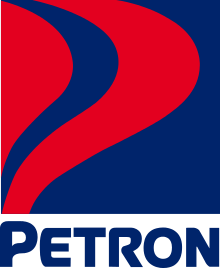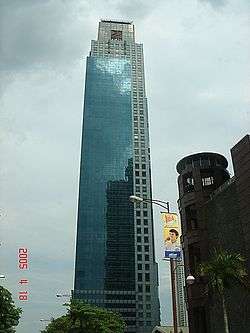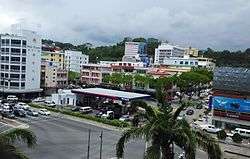Petron Corporation
 | |
| Public | |
| Industry | Oil and Gas |
| Founded | 1933 |
| Headquarters | Petron Megaplaza, Makati, Philippines |
Key people |
Eduardo Cojuangco, Jr. (Chairman)[1] Ramon S. Ang (President and CEO)[2] Lubin B. Nepomuceno (General Manager)[3] |
| Products |
Oil Natural gas Oil refining |
| Revenue |
|
|
| |
| Total assets |
|
| Total equity |
|
Number of employees | 9,236 nationwide |
| Parent | San Miguel Corporation (68.26%)[4] |
| Website |
www |

Petron Corp. (PSE: PCOR) is the largest oil refining and marketing company in the Philippines, supplying more than a third of the country’s oil requirements.
Petron operates a refinery in Limay, Bataan, with a rated capacity of 180,000 barrels per day (29,000 m3/d). From the refinery, Petron moves their products mainly by sea to 32 depots and terminals in the country. They operate a lube oil blending plant at their Pandacan Terminal, where it manufactures lubes and greases.
Petron is public company listed on the Philippine Stock Exchange. A 51-percent stake is owned by the Philippine food and beverage giant San Miguel Corporation (SMC) while the Ashmore Group owns 40 percent. The remaining shares—about 9 percent—are held by the public.
History
Petron's history dates back to September 7, 1933 when the Socony Vacuum Oil Company of New York and Standard Oil of New Jersey formed the Standard Vacuum Oil Company (Stanvac). The end of the venture in the early 1960s split the marketing and refining interests of the company between Mobil (the renamed Socony Vacuum Oil Company) and Esso (the renamed of Standard Oil New Jersey, soon to be Exxon), with its Philippine branch now named Esso Philippines, with offices in Manila and later on in Makati.
In 1953, the Philippine national government, partly to promote Claro M. Recto's national industrialization program and partly to respond to increasing international oil prices, attempted to launch a national oil company that caters Filipino consumers with cheap oil. FilOil, the first Philippine oil company was established as a result, becoming the first national oil firm in Southeast Asia.
In 1973, Esso sold its business to the government which became the Philippine National Oil Company (PNOC). Subsequently, Mobil also sold its share of the refinery to PNOC.
The oil refining and marketing units in PNOC, along with FilOil, were eventually merged to form Petrophil, which was later renamed as Petron Corporation in 1988. Today the company's industrial earnings have never seen such high gains but still trade within the average global yield.
The name Petron used to be a gasoline brand of Petrophil. Launched in 1974, the name came from petroleum (PET) and research octane number (RON).[5]
As part of the government's privatization program, PNOC sought a strategic partner that would give Petron a reliable supply of oil, plus access to state-of-the-art refining technology. The result was a partnership with the world's largest oil producer, Saudi Aramco.
On February 3, 1994, PNOC and Aramco Overseas Co. BV signed a share purchase agreement that gave both a 40% stake in Petron. The remaining 20% of Petron shares were sold to the public.
On August 11, 2006, a Petron oil tanker, the Solar 1, carrying fuel oil sank, causing the Guimaras oil spill, the biggest oil spill in Philippine history.
At the beginning of 2008, the Philippine National Oil Company (PNOC) and Saudi Aramco each owned 40% of the outstanding stock, with the remaining 20% held by thousands of individual stockholders. In 2008, Saudi Aramco sold its entire stake to the Ashmore Group, a London-listed investment group. Then Ashmore added 11 percent more when it made a required tender offer to other shareholders, for a total stake of 51 percent. As of July 2008, Ashmore, through its SEA Refinery Holdings BV, had a 50.57 percent of Petron's stock.[6] Ashmore's payment was made on December 2008.[7] In December 2008, Ashmore acquired PNOC's 40-percent stake. On December 2008, San Miguel Corporation said it was in the final stages of negotiations with the Ashmore Group to buy up to 50.1 percent of Petron.[8]
On March 30, 2012, Petron acquired ExxonMobil's downstream business in Malaysia in with XCEL Petroleum. In January 2013, Petron officially opened their Malaysian operations, rebranding all Esso and Mobil stations across Peninsular Malaysia.[9]
Products and services

The company's ISO-14001-certified refinery processes crude oil into a full range of petroleum products, including LPG, gasoline, diesel, jet fuel, kerosene, industrial fuel oil, solvents, asphalts and mixed xylene.
With their ISO-9000/2000-certified lube oil blending plant, they are also able to produce mechanical lubricants and grease. These products are also sold through service stations and sales centers, and directly to industrial customers.
Through their nationwide network, they supply fuel oil, diesel, and LPG to various industrial customers. Petron's largest client is in the power sector.
They also supply jet fuel at key airports to international and domestic carriers.
Through more than 1,200 service stations, they retail gasoline, diesel and kerosene to motorists and public transport operators. They also sell their LPG brand Gasul to households and other consumers through an extensive dealership network.
Petron is expanding to non-fuels businesses which include convenience store brand "Treats". They have partnered with major fast-food chains, coffee shops, and other consumer services to give customers a one-stop full service experience. They are also putting up additional company-owned and operated service stations in strategic locations.
Petron also opened its first fuel additives blending plant in the Asia-Pacific region at the Subic Bay Freeport Zone in November 2008.
The plant has the capacity to blend 12,000 metric tons (MT) of fuel additives per year. When used in gasoline, diesel, or fuel oil, fuel additives improve efficiency, boost engine performance, and benefit the environment by reducing harmful emissions.
The facility was constructed in partnership with Innospec, a leading global fuel additives supplier, based on an agreement forged in 2006. As part of the agreement, Petron constructed and operated the plant to serve the requirements of Innospec’s customers in the region, including Petron.
Traditionally, Innospec products used in Asia have been sourced from Europe.
In April 2008, Petron also commissioned the country's first petrochemical feedstock units, namely, the Petro Fluidized Catalytic Cracking (PetroFCC) unit and a Propylene Recovery Unit (PRU) at its 180,000-barrel (29,000 m3)-per-day Bataan refinery.
The PetroFCC, the first "cracking" unit of its kind in the world, converts black products (fuel oil) into higher-value LPG, gasoline, and diesel, and yields a higher level of the petrochemical feedstock propylene than typical FCC units.
The PRU further purifies the propylene so that it can be used in making various petrochemical products that are used to manufacture everyday items such as food packaging, appliances, suitcases, furniture, DVDs and even car parts.
Headquarters
Located along Buendia Avenue in Makati, the company's headquarters, the Petron Megaplaza, is a 45-storey building with floor plate area of about 15,512 square meters (166,970 sq ft), which was the Philippines' tallest building before being topped by the PBCom Tower in Ayala Avenue.
Sports team
References
- ↑ http://www.abs-cbnnews.com/business/02/10/15/petron-appoints-danding-cojuangco-chairman
- ↑ http://www.abs-cbnnews.com/business/02/10/15/petron-appoints-danding-cojuangco-chairman
- ↑ http://www.abs-cbnnews.com/business/02/10/15/petron-appoints-danding-cojuangco-chairman
- ↑ Page 48 |Definitive Information Statement - San Miguel Corp. | May 13 2011
- ↑ Road Trip. Top Gear Philippines. p. 9.
- ↑ "Ashmore gets majority of Petron". Inquirer.net. 2008-07-23. Retrieved 2010-08-05.
- ↑ "Ashmore pays P25.7B for stake in Petron". Inquirer.net. 2009-01-05. Retrieved 2010-08-05.
- ↑ "San Miguel tightens grip on Petron". Inquirer.net. 2008-12-24. Retrieved 2010-08-05.
- ↑ "Introducing Petron Corp. of the Philippines, Now in Malaysia" (PDF). Petron Corp. Retrieved 2013-01-23.
External links
- Official website
- Official website (Malaysia)
- Petron Mega Plaza details
- Petron Corporation on Facebook
- Petron Corporation on Twitter